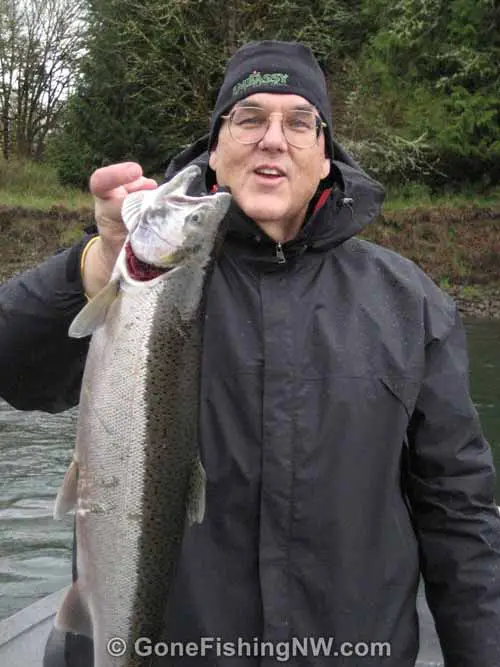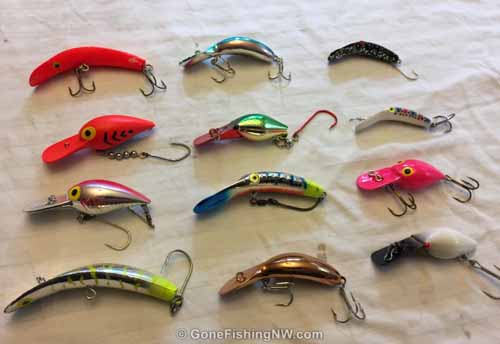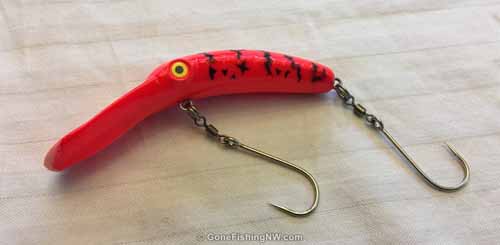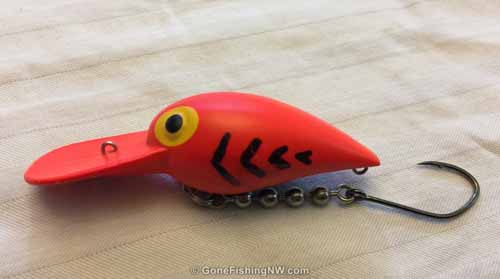Search
Latest Articles
Steelhead Plug Primer Part 1
by Nathan Nesbit of GoneFishingNW.com, December 05, 2016
Like most species of fish there are multiple ways to fish for them. This guide covers how to catch steelhead using plugs. A plug is a hard bodied fishing lure which wiggles and dives. Mainly this technique is used from a boat, but I’ll also cover how to use them from shore.
This article is a condensed version of the full article on GoneFishingNW.com. To dive deeper into the world of plug fishing, please check out the full length article.
About A Fish
Some people confuse steelhead with salmon, but they are quite different. Others call any large rainbow trout a steelhead.
A steelhead is really a rainbow trout which, like a salmon, has migrated out to sea and then back to freshwater to spawn. I’ll grudgingly include the Great Lakes in the definition of “sea” for our brothers in the east.

Unlike a salmon, steelhead are not genetically programed to die after spawning. However due to the stresses of migrating and spawning there is a large mortality rate.
The exact timing of the runs and spawning varies from river to river, so make sure to do your homework before hitting the water.
Rod, Reel and Line
Before you can hit the water you need to make sure you have the right gear. Technically you could use any rod and reel, but you’ll find more success using a rod made for the technique. That means more bites and landing more fish.
Specialty plug rods are often called hot shot rods or kwik rods – named after popular plug lure models.
An ideal steelhead plug rod will have a sensitive tip that will let you know the plug is working properly. It will also have a fast action, to get a solid hookset when the fish hits the lure. It should be between 7’6” and 8’6”. The ideal rod will also have a line rating around 6 to 15 pounds.
The reel should be rated to hold 150 to 180 yards of 10 pound mono. Which brings us to what type of line to use.
If you like mono line, then use 10 or 12 pound line. High visibility line can be very helpful while fishing, especially if multiple people are fishing. If you prefer the traditional “clear” line then it is hard to beat the performance of Maxima Ultragreen.
If you like braided line, then 30 to 40 pound line works well. You can get high visibility, or moss green.
Regardless of your mainline type, finish it off with a size 7 swivel and then 4 or 5 feet of 8 pound fluorocarbon leader.
Build A Plug Collection
The first time I fished with a die hard plug fisherman I was blown away by the number of plugs he had on the boat. He probably had 8 or 10 plano boxes – each packed full of plugs. Different styles, sizes and colors.
Plan on starting with at least five or six different plugs. Then as you decide to fish plugs more, grow your collection.
Plug Styles
There are three styles of steelhead plugs – banana style, wiggler style and rocker style. The banana style are plugs like flatfish, kwikfish and maglips. Wiggler style are Brad’s Wigglers, FatFish, Hot Shots and Wiggle Warts. Rockers consist of Tad Pollys and River Rockers.

In most cases having specific styles aren’t as important as having a variety of plugs that dive to different depths and can handle different current speeds.
Plug Sizes
Just about every lure comes in a variety of sizes. For steelhead, you’ll want lures which range from about 1 1/2 inches to 4 1/2 inches.
The sweet spot though is usually 2 to 3 1/2 inches. With a collection of plugs in that range you’ll be able to handle all but the most extreme conditions.
You’ll want some small plugs, around 2 inches long. Most in the 3 inch range, and a few larger ones.
Water Speeds
You can tell if a lure can handle a given current speed by putting it in the water with about 6 feet of line out, and seeing how it runs.
If it has trouble wiggling or staying under the surface then the water speed is too slow for it. If the wiggle seems extreme or the lure spins at all, then the water speed is too fast.
Water that is just right for the plug will produce a strong diving action and a nice steady wiggle.
You will want some plugs for each of the different speeds of water you may fish. Flatfish do well in slower currents. Hot Shots and Tad Pollys in medium water. MagLips work in just about all water, including faster water.
Diving Depths
As for diving depth, you should take any specific depth from the packaging with a grain of salt, and treat it more as a category. Try to have some plugs that dive down to 6 feet, some that dive to 12 feet and a few that dive deeper.
Plug Colors
Each model of plug and each size come in a variety of colors and patterns. You’ll want a decent variety of colors for the different conditions and fish preferences.
Mostly you’ll want to use metallic colors. These work in a variety of conditions and have both solid colors and pattern variations. Focus your collection on these colors.
• Copper
• Gold
• Silver
• Blue or Green in metallic variants
For other conditions have some different colors like black, crawfish, cop car and fluorescent red.
Configure Your Plugs
In many places, you can use the plug straight out of the box. However, you mean need to modify the plug in order to comply with the regulations on a specific river system, or to improve its performance. I modify most of my plugs, and believe it helps me hook and land more fish.
Single Point Hooks
I’m a big fan of single point hooks. I think they result in a better hook to land ratio. Not to mention that single point hooks are required in some of the places that I fish.

If the manufacturer has provided instructions on how to replace the stock treble hooks with single hooks, then follow those instructions.
Assuming they didn’t provide instructions, these will work for most lures:
1. Select a replacement hook. Typically, this is going to be an open eye siwash hook. The hook gap (distance between the shaft and hook point) should be as 1 to 1.5 times as big as the hook gap on the stock treble.
2. Remove the stock treble. I usually just cut them off.
3. Thread a small swivel, typically size 7, onto the split ring still attached to the screw eye.
4. Attach the hook eye to the other end of the swivel. With pliers close the eye of the hook.
a. If using closed eye hooks, then use a split ring to connect the hook to the swivel.
5. Make sure the screw eyes are still aligned with the lure body. If not, then adjust them.
Changing Hook Placement
Wiggler style plugs, like Hot Shots, often have the hook fairly close to the body. You can get a better hookup if the hook is a little bit farther from the body. Regardless if you are sticking with treble hooks or switching to siwash single hook, you want the point of the hook to be about 1/2 to 3/4 of an inch behind the lure.

Simply follow these steps:
1. Remove the hook from the split ring.
2. Take a bead chain and thread it onto the split ring.
3. Connect the hook to the other end of the bead chain.
• If you are using an open eye hook, then you can crimp the eye around the end of the chain.
• If you are using a closed eye hook, then use another split ring to connect it to the chain.
4. Make sure the screw eye is still aligned with the body of the lure.
Advanced Plug Customization
As you get into it, you’ll find that you want to customize the plugs to achieve that slight edge – especially in those home waters that you fish a lot and have unlocked at least some of its secrets.
One easy way to customize plugs is with magic, or permanent, markers. The markers come in a variety of colors – not just black. Want a copper plug with red spots? Well just buy a solid copper plug, and add dots with a red marker. I do find that you need to occasionally go through your collection and touch up the plugs, as the ink does seem to fade and wash off a little.
Conclusion
You should now have a good idea of what kinds of plugs catch steelhead, and what you should have in your tackle box. You can also customize your lures by replacing or adjusting the hooks, and by adding a custom color scheme.
Part 2 will teach us how to select the right water to fish, what plug to select for the conditions, how to ensure our plugs are working properly and how to work a hole.
Good luck and Tight Lines!




